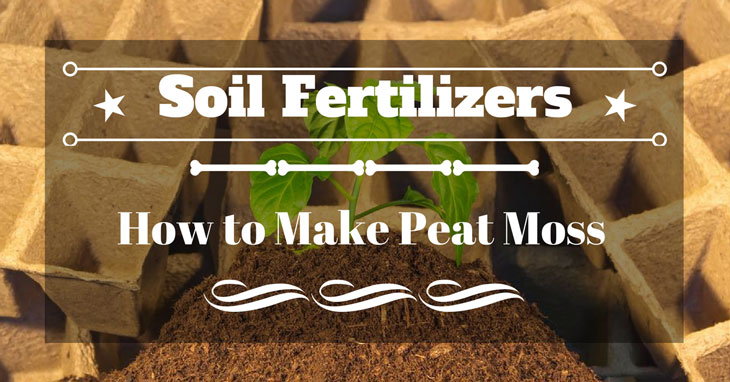How to Make Peat Moss in Super Easy Steps
If you are a gardener, you might have already heard about peat moss. They do an amazing job for the soil and thus, can improve plant growth. Are you interested to know how to grow peat moss? You’ll be surprised to know they are easy to grow. In this guide, I will tell you more about peat moss and give you tips in making them.
More...
What is Peat Moss?
Peat moss is a fibrous material that forms when the mosses and other living materials decompose in peat bogs. Oftentimes, they are called sphagnum peat moss because it is mostly composed of sphagnum which is a type of moss.
The process of decomposition to form peat moss is very slow and it happens without the presence of air. Typically, peat bogs grow less than a millimeter per year. While the process to grow peat moss takes time, the resulting product is worth the wait because of its many benefits.

Qualities of Peat Moss
- Absorbent – Peat moss does well in absorbing water, more like a sponge. Its ability to absorb water is better than average soil. Moreover, it prevents the nutrients from leaching out of the soil.
- Does not compact – unlike most organic materials, peat moss does not easily compact. Soil compaction reduces water absorption, and it also hinders plant growth. Even when wet, peat moss remains springy. Because of this quality, peat moss allows for better aeration for the plant.
- Sterile – it does not contain harmful pathogens, weed seeds and other microorganisms that can be harmful to plants.
- Acidic – peat moss has a slightly acidic pH level which is great for acid-loving plants.
Uses of Peat Moss in the Garden
- 1. Ingredient in potting soil – If you are growing blueberries and other acid-loving plants, you could add peat moss in your potting soil. You may still use peat moss if you are planning to grow plants that require alkaline pH, but doing so requires adding alkaline amendments.
One good thing about peat moss is that they don’t easily break down. A single application of peat moss could last for several years. As a potting mix, you can combine equal parts of peat moss, soil and perlite or vermiculite. But this is not a fixed rule. Don’t be afraid to play around with the ratio as well as the components that you can add into the mix until you find the perfect potting mix.
- 2. Seed-starting medium – unlike poorly prepared compost which may contain microorganisms and weed seed that will compete with the seedlings, peat moss is a sterile medium. It also supports the growth of the seeds as it holds moisture and nutrients and releases them to the roots when needed.
- 3. Soil amendment – If you want to use the peat moss as a soil amendment, the ideal ratio is one-part peat moss and two parts soil. Distribute the mix evenly in your garden before planting.
- 4. Fertilizer – According to an article published by the University of Vermont Extension, peat moss has few nutrients, if any, so it does not work like the regular compost that supplies nutrients to the soil. However, peat moss helps the soil hold nutrients by increasing CEC. CEC stands for Cation Exchange Capacity which pertains to the ability of the soil to hold positively charged ions. CEC affects the soil’s structure stability, pH level and nutrient availability.

Disadvantage of Peat Moss
As with many gardening materials, there are also some downsides in using peat moss. One of them is price. Peat moss is expensive and the more volume you use in your garden, the higher your associated expense will be.
Prices for peat moss depend on the brand and the size of the bag. Smaller bags are usually sold by quart which may cost between $1 and $2 per quart.
Peat moss is a widely available garden resource. You can buy it in most garden stores and centers across the country. You can also order it online.
If you think that purchasing peat moss is just too expensive for you, why not make your own? Peat moss is like garden compost that you can easily make out of materials that you may already have.
How to Make Peat Moss?
You’ll need:
- Sphagnum moss
- Potting container or a hole in the ground
Procedure:
1. Find a clump of live sphagnum moss in your garden.
2. Trim the top 3 inches of the sphagnum moss clump. This part is the most productive part of the sphagnum moss and it yields better results.
3. Pull the clump apart into small pieces of approximately 1 inch in diameter.
4. Find a shady area where you can put your potting container. If you have such place in your backyard, the best option is to dig a hole.
Be sure that your container or hole can handle the amount of peat moss you are planning to grow. Typically, one square foot of moss will produce 10 square feet of growth.
5. Put top soil or compost inside the container or hole. Don’t overfill but leave several inches from the rim to the base of the soil. Place the pieces of moss clumps in the middle in a dense concentration.
6. Keep the peat moss moist by spraying water. Occasionally, you can water it until the water slightly covers the moss.

This method of growing sphagnum moss is published in eHow but I slightly reworded the procedures and removed the use of fertilizer as other sources did not use it. Also, if you are growing sphagnum moss for use in an aquarium, you should not use any fertilizer or chemicals in the process because they can be fatal to fishes.
Since the actual peat moss is the decaying sphagnum moss, the above procedure is just one part of the whole process. Once you have grown the sphagnum moss, you need to facilitate its decomposition and here is how to do that:
1. Make sure that the temperature inside the container or hole is between 70 to 75°F. Decomposition happens when the temperature is warm.
2. Make sure that the moss receives limited amount of light.
3. Let the moss grow for up to seven months or when a sizeable mat of moss has already formed. You can then cut out some sections of the mat and let it dry.
4. Once dry, the resulting brown matter is your sphagnum peat moss.
Controversy in Using Peat Moss
Many people feel guilty when using peat moss because of the environmental concerns attached to how they are obtained. In the US, most of the peat moss sold in the market are mined from the remote bogs in Canada. The International Peat Society and other environmental groups point out that the mining process is carbon intensive. They release a massive amount of carbon in the atmosphere which in turn limits the ability of the bogs or peatland ecosystem to work as a carbon sink. This in turn can have a negative impact on climate change.
You are making your garden and the environment a favor if you will make your own peat moss and use it sparingly for your gardening project.
Conclusion
Peat Moss can offer numerous benefit to your garden. However, there are environmental issues attached to how they are sourced by retailers. And they are also considerably more expensive when sold in the market. Learning how to make peat moss from scratch can help you save money, help the environment, and grow your plants without guilt.
References:
https://www.gardeningknowhow.com/garden-how-to/soil-fertilizers/peat-moss-information.htm
Did you find this article helpful? Please share with us your thoughts through the Comment section. You may also like to share this article with your friends.

